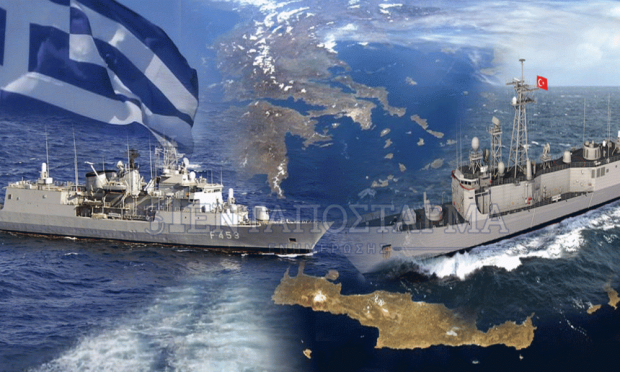Some military programs currently being pursued by Turkey have the potential to change the military balance in the Aegean from the late 2020s onwards, to the point where Greece is unlikely to ever close the gap in quality and quantity, two western experts claim.
However, as we see in the war in Ukraine and elsewhere, shows that none of this is true. Especially in the case between Greek and Turkish forces, the difference is small at the moment with the tendency to equalize in the coming years and surpass Turkey in areas such as the Air Force and the Navy.
The two experts mention the Turkish equipment plan, "with Bayraktar Akıncı and Kızılelma unmanned combat aircraft, TF-2000 destroyers, a fleet of armed unmanned surface vessels, six Reis Type-214TN class submarines with air-independent propulsion and possible construction of small-sized attack submarines ST-500.
All of these weapon systems are to augment Turkey's fleet of around 170 armed drones that already conduct regular patrols in the Aegean.
Greece for its part does not yet have armed UAVs, with its UAV inventory currently consisting of just four leased IAI Heron TPs. While the Hellenic Air Force's fighter jet inventory will be more modern and capable than Turkey's during the 2020s and early 2030s, the oft-repeated claim that Greece is set to enjoy air superiority over the Aegean likely it has no response to reality.
In the event of an (unlikely) full-scale war, a significant portion of Greece's fighter aircraft would have to be dedicated to air-to-ground missions to compensate for the country's lack of UCAVs, as it has a small fleet of attack helicopters and artillery but also short-range MRLS.
In contrast, the Turkish Air Force can devote a much larger portion of its F-16 fleet (240 in number), with around 170 UCAVs and around 70 attack helicopters available to provide protection to ground and naval forces. Of these, Bayraktar Akıncı and Kızılelma are increasingly capable of replicating the capabilities of manned combat aircraft and are essentially the world's first operational multi-role unmanned combat aircraft.
Their capabilities will not only include the deployment of an extensive arsenal of domestically produced cruise missiles and anti-aircraft munitions, but also the launch of beyond-visual-range air-to-air missiles (BVRAAMs) at aerial targets flying at a distance of up to 100 km.
This does not mean that Greece is left defenseless, since it has an extensive network of MIM-104 Patriot, S-300PMU-1, MIM-23 Hawk, Crotale-NG, Skyguard, 9K33 Osa and Tor-M1 SAM systems that are ready, while air operations over the Aegean are a nightmare for the Turkish Air Force. Be that as it may, a large part of the munitions that are going to arm the Turkish UCAVs, F-16s and the future TF-X fighters, surpass almost all Greek air defense systems.
Even if we ignore Turkey's UCAV fleet, the country has many more systems that could be used to neutralize Greek SAM sites and systems. These include the KORAL and REDET-II electronic warfare systems, the J-600T Yıldırım and Bora short-range ballistic missiles (SRBMs), and soon the Tayfun SRBM and KARA Atmaca cruise missiles (GLCMs).
The KARA Atmaca was introduced in August 2021 carried on a wheeled vehicle and is a variant of the Atmaca anti-ship missile. It was developed by Roketsan to meet a Turkish Army requirement for high-precision GLCM missiles with a range of 280+km. Although this virtue makes it the world's shortest-range surface-to-surface cruise missile, its range is still sufficient to neutralize most Greek anti-aircraft missile sites when launched from locations along Asia Minor.
The KARA Atmaca missile is technically capable of being launched from submarines as well (like the Atmaca AShM version), while Turkey is already developing the 1000+km range Gezgin Cruise Missile (LACM) specifically for this purpose.
Turkish SRBMs such as the Bora are more susceptible to interception by SAM systems such as the MIM-104 Patriot system due to their high flight trajectory. In contrast, the KARA Atmaca missile will prove much more difficult to intercept due to its ground-following (NOE) trajectory.
The geography of the Aegean will also work to the advantage of the Turkish missile, which flies low enough to make use of natural features such as mountains and canyons to evade detection before hitting its target at long range.
Through the development of the KARA Atmaca GLCM, Gezgin LACM and the Tayfun SRBM, Turkey will soon have a variety of high-precision long-range weapon systems for use in the Aegean theater and beyond.
The recurring trend with each of these developments is not only that Greece currently lags behind in military developments compared to Turkey, but also that Turkey's efforts to expand its military capabilities continue to outpace Greece to the point where unlikely to ever bridge the gap," the article concludes.
We think that all this is not true and our country has now started to develop strategic possibilities, which we must see in the coming years as quickly as possible.



